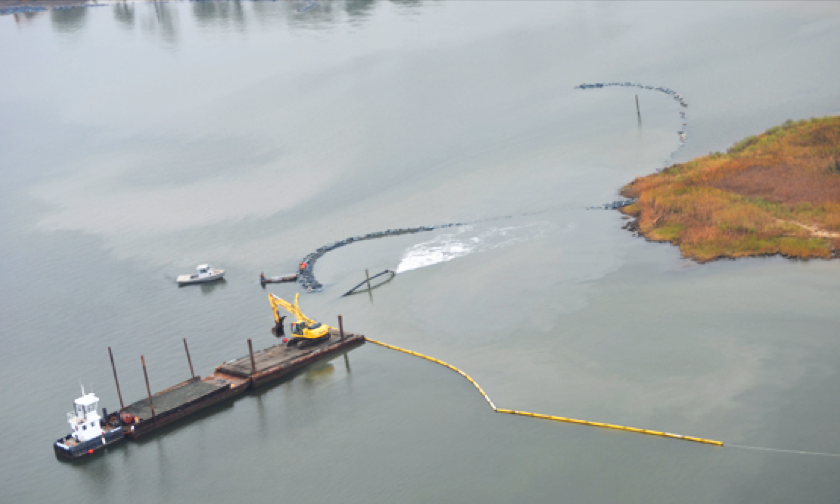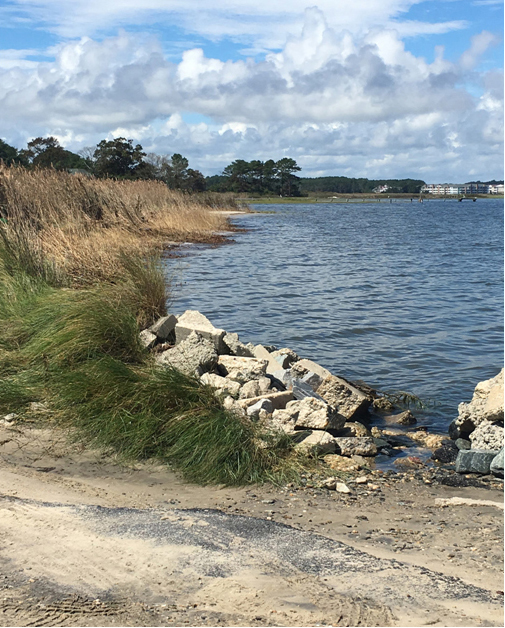 In 2001, Maryland passed the Dredged Material Management Act and defined Maryland’s “Beneficial Uses” of dredged material, including marsh enhancement, beach nourishment, shoreline stabilization, and island restoration. These beneficial uses can increase shoreline and community resilience while dramatically reducing the financial costs of dredged material disposal and coastal restoration projects. For beneficial use projects to occur, dredging and restoration projects must be aligned in space and time, and the dredged material must be suitable per the
Maryland Department of the Environment guidelines for the given restoration project. The Chesapeake and Coastal Service (CCS) is pursuing the following opportunities to better align dredging and restoration to realize those benefits.
In 2001, Maryland passed the Dredged Material Management Act and defined Maryland’s “Beneficial Uses” of dredged material, including marsh enhancement, beach nourishment, shoreline stabilization, and island restoration. These beneficial uses can increase shoreline and community resilience while dramatically reducing the financial costs of dredged material disposal and coastal restoration projects. For beneficial use projects to occur, dredging and restoration projects must be aligned in space and time, and the dredged material must be suitable per the
Maryland Department of the Environment guidelines for the given restoration project. The Chesapeake and Coastal Service (CCS) is pursuing the following opportunities to better align dredging and restoration to realize those benefits.
BUILD tool
The key to implementing beneficial use projects is ensuring that restoration and dredging projects spatially align. BUILD, or “Beneficial Use: Identifying Locations for Dredge”, is an ArcGIS layer available in the
Maryland Coastal Atlas that enables the spatial identification of beneficial use of dredged material opportunities. BUILD allows project planners to proactively identify sources of dredged material to place in restoration projects, or vice versa. Learn more about BUILD through the associated
user manual and
story map, or contact Maggie Cavey at
[email protected] or (410) 260-8904.
Policy and guidance
To ensure that dredged material is placed and utilized in environmentally responsible ways, the department is developing a policy, “Dredged Material Placement on Resources Managed by the Department of Natural Resources”, that will be accompanied by a process guidance, “Beneficial Use of Dredged Material Planning Process”, both expected to be complete by the end of 2019. Before pursuing a project that may beneficially use dredged material, the policy and guidance will help project planners understand the requirements and recommendations for implementing these types of projects. To learn more, contact Maggie Cavey at
[email protected] or (410) 260-8904.
Demonstration projects
 Chesapeake and Coastal Service believes in the value of beneficially using dredged material. Through the
Living Shorelines program, the
Waterways Improvement Fund, and the
Community Resilience Grant Program, Chesapeake and Coastal Service is demonstrating the environmental, societal, and financial benefits of incorporating dredged material into shoreline restoration projects. To learn more about some of the beneficial use projects that Chesapeake and Coastal Service has supported, visit the
Beneficial Use Demonstration Projects story map.
Chesapeake and Coastal Service believes in the value of beneficially using dredged material. Through the
Living Shorelines program, the
Waterways Improvement Fund, and the
Community Resilience Grant Program, Chesapeake and Coastal Service is demonstrating the environmental, societal, and financial benefits of incorporating dredged material into shoreline restoration projects. To learn more about some of the beneficial use projects that Chesapeake and Coastal Service has supported, visit the
Beneficial Use Demonstration Projects story map.
Photo Caption: The Selsey Road Shoreline and Marsh project is funded through the FY19 Community Resilience Grant Program. Pictured is the project shoreline prior to construction. The project will incorporate high quality, sandy dredged material to stabilize the shoreline and restore the marsh.
Research
 Elevation enhancement, also known as thin-layer placement, is a marsh restoration technique that uses dredged material to add sediment to a marsh to help the marsh combat processes such as sea level rise, erosion, and subsidence. Though elevation enhancement has been used for decades in southern states such as Louisiana, the technique has not been widely used in the Mid-Atlantic region. To better understand the practice of elevation enhancement, the Maryland Chesapeake Bay National Estuarine Research Reserve (CBNERR-MD) is participating in a
NERRS Science Collaborative Project on Thin-Layer Placement. The study is occurring at eight NERR sites across the country to help identify the impacts of dredged material depth and quality on the response of marshes to elevation enhancement. Results from the study will help inform elevation enhancement best-management practices across the country. To learn more about the Science Collaborative project and the Chesapeake Bay National Estuarine Research Reserve in Maryland, visit the
A Marsh Community story map, or contact Rebecca Swerida at
[email protected] or 410-260-8722.
Elevation enhancement, also known as thin-layer placement, is a marsh restoration technique that uses dredged material to add sediment to a marsh to help the marsh combat processes such as sea level rise, erosion, and subsidence. Though elevation enhancement has been used for decades in southern states such as Louisiana, the technique has not been widely used in the Mid-Atlantic region. To better understand the practice of elevation enhancement, the Maryland Chesapeake Bay National Estuarine Research Reserve (CBNERR-MD) is participating in a
NERRS Science Collaborative Project on Thin-Layer Placement. The study is occurring at eight NERR sites across the country to help identify the impacts of dredged material depth and quality on the response of marshes to elevation enhancement. Results from the study will help inform elevation enhancement best-management practices across the country. To learn more about the Science Collaborative project and the Chesapeake Bay National Estuarine Research Reserve in Maryland, visit the
A Marsh Community story map, or contact Rebecca Swerida at
[email protected] or 410-260-8722.
Funding and technical support
In some cases, Chesapeake and Coastal Service is able to provide support for beneficial use projects where the project goals fit with existing funding objectives. If beneficial use projects address waterway access for the recreational boating public, community resilience goals, and/or shoreline conservation, funding may be available through Chesapeake and Coastal Service’s existing grant and loan programs:
Waterway Improvement Fund
Supports the general boating public in Maryland by providing funds to 1) construct, renovate, or maintain boating access facilities; 2) dredge channels and harbors; 3) purchase fireboats in partnership with local fire companies.
Community Resilience Grant Program
Helps to address the impacts of climate-related hazards by 1) understanding risk; 2) planning for hazard mitigation; and/or 3) implementing projects that use nature-based features to improve community resilience.
Shoreline Conservation Service
Provides technical and financial assistance for design and installation of living shoreline and streambank restoration projects.
Contact the designated grant program managers to learn if your beneficial use project qualifies.